Published online by Cambridge University Press: 11 February 2009
The romance of Leucippe and Clitophon had already been edited by I. and N. Bonnvitus (ed. prin. Heidelberg, 1601), Salmasius (1640), Boden (1776), and Mitscherlich (1792), but it was the work of Friedrich Jacobs, published in 1821, that provided the foundation for serious criticism of the text based on knowledge of a substantial number of representative manuscripts.
2 Gnomon 30 (1958), 585. At 8.14.5.15 W apparently has ![]() which merits some consideration since it avoids the element of redundancy in
which merits some consideration since it avoids the element of redundancy in ![]() , however suitable
, however suitable ![]() , may otherwise seem; 8.17.3.19
, may otherwise seem; 8.17.3.19 ![]() (W sec. Russo) is of course right against the augmented optative
(W sec. Russo) is of course right against the augmented optative ![]() (W sec. Vilborg), and we hardly needed a manuscript to tell us that.
(W sec. Vilborg), and we hardly needed a manuscript to tell us that.
3 On book 1, e.g. p.14 n.1 ‘The MSS. all have ![]()
![]() p.40 n.1 Salmasius did not merely add
p.40 n.1 Salmasius did not merely add ![]() p.46 n.1 mirrors the strangeness of Vilborg's apparatus; p.48 n.1 Hercher believed that the manuscripts had
p.46 n.1 mirrors the strangeness of Vilborg's apparatus; p.48 n.1 Hercher believed that the manuscripts had ![]()
![]() arranged and gives the wrong impression that
arranged and gives the wrong impression that ![]() is not in the a text and that Jacobs wanted to delete it.
is not in the a text and that Jacobs wanted to delete it.
4 I am very grateful to Prof. W.G. Arnott, Mr. M.D. Reeve, and Mr. E.W. Whittle for reading the notes in manuscript and letting me have their comments. I have not always taken their advice, perhaps unwisely, and the faults that remain are mine alone.
5 In referring to the texts of the editors I use the editors' names abbreviated as follows: Ja(cobs), Hi(rschig), He(rcher), Ga(selee), Vilb(org).
6 Acbilles Tatius Leucippe and Clitopbon A Commentary (Studia Graeca et Latina Gotboburgensia XV) (Göteborg, 1962), p.20.Google Scholar
7 e.g. at 1.1.2.8; 1.2.9; 1.6.17–18; 1.7.19; 1.11.14–15; 1.11.15–16; cf. 1. 12.21; 2.1.3; 2.2.5;3.2.1; 4.1.25; 5.2.20; 5.3.25; 5.5.5;6.1.19.
8 The sense ‘to dip’ is not, of course, appropriate.
9 For ![]() see Comm., p.22.
see Comm., p.22. ![]() cf. 4.18.6.8.
cf. 4.18.6.8.
10 Not used by Ach. Tat.
11 Both here and in Ach. Tat. the likeness is between ![]() , and blood: in Ach. Tat. the blood in the cheeks of Leucippe, in Homer the blood on the thighs of Menelaus, is compared to the dye used for a cheek-piece.
, and blood: in Ach. Tat. the blood in the cheeks of Leucippe, in Homer the blood on the thighs of Menelaus, is compared to the dye used for a cheek-piece. ![]() is clearly the colour of blood in Ach. Tat. 2.11.5–7.
is clearly the colour of blood in Ach. Tat. 2.11.5–7.
12 Note ![]()
![]() suitable than the Homeric
suitable than the Homeric ![]() , a word with strong connotations of defilement that he would not want to suggest in this context. Heliodorus, probably echoing the same passage of Homer, has (10.15)
, a word with strong connotations of defilement that he would not want to suggest in this context. Heliodorus, probably echoing the same passage of Homer, has (10.15)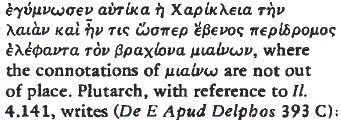
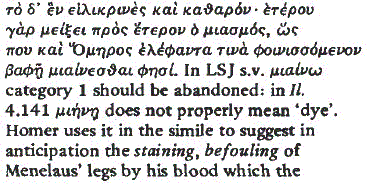
 .
.
13 Cf. 1.5.3.21 ![]() cf. 1.5.6.9
cf. 1.5.6.9 ![]() .
.
14 Apart from considerations of word-order, it cannot go with ![]() in sense (see Vilb, . Comm., p.24): there is no reason why Ach. Tat. should say whether Clitophon was showing any outward signs of his emotional state, since there was no one to observe them; we would hardly be told that his feelings were clear to himself; and I do not believe
in sense (see Vilb, . Comm., p.24): there is no reason why Ach. Tat. should say whether Clitophon was showing any outward signs of his emotional state, since there was no one to observe them; we would hardly be told that his feelings were clear to himself; and I do not believe  .Google Scholar
.Google Scholar
15 Retrospective ![]() of the kind we have here, with asyndeton, is always at (or, in the case of 1.3.5.17 and 2.1.3.11, as near as possible to) the beginning of its sentence: in the first two books see 1.2.1.2; 4.1.23; 5.3.7; 8.2.19; 19.1.4; 2.1.3.11; 5.1.1; 6.1.13; 6.3.20; 10.2.9; 14.6.4; 15.1.4; 19.2.23; 19.6.11; 22.7.16; 27.3.1; 28.3.15; 31.1.18. Specially relevant to 1.7.2–3 are these places, in which the demonstrative refers to a person just introduced (or, as in 1.3.5.17, revived for his role in the plot):
of the kind we have here, with asyndeton, is always at (or, in the case of 1.3.5.17 and 2.1.3.11, as near as possible to) the beginning of its sentence: in the first two books see 1.2.1.2; 4.1.23; 5.3.7; 8.2.19; 19.1.4; 2.1.3.11; 5.1.1; 6.1.13; 6.3.20; 10.2.9; 14.6.4; 15.1.4; 19.2.23; 19.6.11; 22.7.16; 27.3.1; 28.3.15; 31.1.18. Specially relevant to 1.7.2–3 are these places, in which the demonstrative refers to a person just introduced (or, as in 1.3.5.17, revived for his role in the plot): ![]() 2.4.2.14; 13.1.19; 20.1.13. Cf. the use of
2.4.2.14; 13.1.19; 20.1.13. Cf. the use of ![]() at the beginning of its sentence and referring to a place just introduced: 1.1.2.6; 4.12.8.18.
at the beginning of its sentence and referring to a place just introduced: 1.1.2.6; 4.12.8.18.
16 ![]() The fut. is wrong and probably due to wrongly taking
The fut. is wrong and probably due to wrongly taking ![]() .
.
17 Read by all the editors except Iiercher who reads with F.
18 1.6.3.3;6.19.4.21.
19 Gaselee's note on ![]() is ‘Headlam’s correction for MSS.
is ‘Headlam’s correction for MSS. ![]() Warmington reproduces this inaccuracy.
Warmington reproduces this inaccuracy.
20 ![]()
![]() question of Ach. Tat.'s use of
question of Ach. Tat.'s use of ![]() with the potential optative is a vexed one. At 8.6.15.17 a recently discovered papyrus
with the potential optative is a vexed one. At 8.6.15.17 a recently discovered papyrus ![]() reading is perhaps
reading is perhaps ![]()
![]() .
.
21 ![]() M. The emphatic pronoun seems necessary: there is a contrast between Clitophon, who received Melite's attention, and the food, which she neglected.
M. The emphatic pronoun seems necessary: there is a contrast between Clitophon, who received Melite's attention, and the food, which she neglected.
22 See LSJ ![]() and Vilb, . Comm., p.27.Google Scholar
and Vilb, . Comm., p.27.Google Scholar
23 Tyrwhitt's ![]() (see Dawes, R., Miscellanea Critica ex recensione Thomae Kidd (London, 18272), p.612) has not enjoyed much attention, happily enough: it is an improbable poëticism of no suitable sense, arrived at, in Tyrwhitt's argument, by high-rise palaeographics.Google Scholar
(see Dawes, R., Miscellanea Critica ex recensione Thomae Kidd (London, 18272), p.612) has not enjoyed much attention, happily enough: it is an improbable poëticism of no suitable sense, arrived at, in Tyrwhitt's argument, by high-rise palaeographics.Google Scholar
24 ![]() 3.1.4.14; 5.5.4.12
3.1.4.14; 5.5.4.12 ![]() (Villoison:
(Villoison: ![]() codd.).
codd.).
25 ![]() also at 4.6.3.26; 8.9.3.15; 10.5.7.(after Aeschines 1.61), always of persons.
also at 4.6.3.26; 8.9.3.15; 10.5.7.(after Aeschines 1.61), always of persons.
26 Comm., p.28.
27 The alternative is ![]()
![]() .
.
28 The same form of expression (always with ![]() ) occurs in Thuc. 5.13.2; 5.14.1; 5.44.
) occurs in Thuc. 5.13.2; 5.14.1; 5.44.
29 Intrans. ![]() with adv. (without gen.
with adv. (without gen.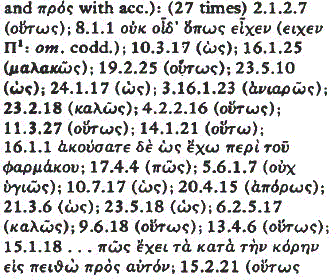
 .
.
30 Always ![]() 1.6.6.17; 6.5.5.19; 11.2.25.
1.6.6.17; 6.5.5.19; 11.2.25.
31 This adv. does not occur elsewhere in Ach. Tat., but ![]() is found at 3.22.4.7. For
is found at 3.22.4.7. For ![]() Pl. Smp. 176 C.
Pl. Smp. 176 C.
Since ![]() refers primarily to mental disposition, it might seem unsuitable for use with
refers primarily to mental disposition, it might seem unsuitable for use with ![]() , but there is a contrast here between
, but there is a contrast here between ![]() and
and  .
.
32 ![]() 7.12.5.19.
7.12.5.19.
33 ![]() 1.6.3.25; 16.2.9; 18.5.1; 6.2.6.19; 7.7.8.6; 8.10.2.18.
1.6.3.25; 16.2.9; 18.5.1; 6.2.6.19; 7.7.8.6; 8.10.2.18.
34 ![]() . Emendationen and Interpretationen zu griechischen Prosaikern der Kaiserzeit. V, Zu den Romanschriftstellern (Lund, 1945), p.21.Google ScholarVilborg, (Comm., p.28) approves Witstrand's view.Google Scholar
. Emendationen and Interpretationen zu griechischen Prosaikern der Kaiserzeit. V, Zu den Romanschriftstellern (Lund, 1945), p.21.Google ScholarVilborg, (Comm., p.28) approves Witstrand's view.Google Scholar
35 The second ![]() refers to an actual physical ‘attempt’ to have intercourse with the girl; the third
refers to an actual physical ‘attempt’ to have intercourse with the girl; the third ![]() would signify ‘an approach’, ‘an attempt’ to win her over of quite the opposite kind.
would signify ‘an approach’, ‘an attempt’ to win her over of quite the opposite kind.
36 Read by Hirschig.
37 Only here in apodosis to a conditional clause. Cf. 8.10.12.8; 17.3.20. (Neither of these instances of ![]() , the only ones in Ach. Tat. at all relevant, is very secure in itself.)
, the only ones in Ach. Tat. at all relevant, is very secure in itself.)
38 Jacobs, p.454, says only, ‘Ceterum in hoc periodo oratio non consist. Post ![]() apodosin excidisse apparet’, and he does not suggest any supplement. To join
apodosin excidisse apparet’, and he does not suggest any supplement. To join ![]() with what precedes, as Salmasius and Boden did, is obviously inept.
with what precedes, as Salmasius and Boden did, is obviously inept.
39 Note in this same clause ![]()
![]() , wrongly.
, wrongly.
40 See Denniston, J. D., The Greek Particles (Oxford, 1954 2), pp.206 and 224 f. Emphatic ![]() is fairly common in Ach. Tat. (e.g. 1.6.1.17; 2.21.3.2; 3.3.2.18; 4.1.6; 19.3.13; 20.6.3).
is fairly common in Ach. Tat. (e.g. 1.6.1.17; 2.21.3.2; 3.3.2.18; 4.1.6; 19.3.13; 20.6.3). ![]() , however, does not occur elsewhere and
, however, does not occur elsewhere and ![]() ) is not found in apodosi. The corruption of
) is not found in apodosi. The corruption of ![]() and vice versa is, of course, very frequent: see e.g. Ach. Tat. 1.3.4.10; 3.6.21; 4.1.26; 2.4.1.8; 4.3.16; 11.2.2; 11.3.7; 20.3.21; 35.2.11; 3.1.3.8; 4.3.14.Google Scholar
and vice versa is, of course, very frequent: see e.g. Ach. Tat. 1.3.4.10; 3.6.21; 4.1.26; 2.4.1.8; 4.3.16; 11.2.2; 11.3.7; 20.3.21; 35.2.11; 3.1.3.8; 4.3.14.Google Scholar
41 Vilborg, (Comm. p.29) says that the ![]() of previous editors has no manuscript authority. Anyway
of previous editors has no manuscript authority. Anyway ![]() would be entirely unsuitable as an antithesis to
would be entirely unsuitable as an antithesis to  .Google Scholar
.Google Scholar
42 In this interpretation I do not understand how the play is already being acted before it has even been accepted. (There is no question of a preliminary audition: in his advice Clinias is talking about the real performance.)
43 ![]() is a little strange. It hardly refers irrelevantly to literary authorship. The lover is the protagonist and is probably thought of as improvising to meet the circumstances as he goes along.
is a little strange. It hardly refers irrelevantly to literary authorship. The lover is the protagonist and is probably thought of as improvising to meet the circumstances as he goes along.
44 For ![]() with the sense ‘ruin’ in Ach. Tat. see 1.8.9.18; 2.24.1.18
with the sense ‘ruin’ in Ach. Tat. see 1.8.9.18; 2.24.1.18 ![]() .
.
45 This would need something like ![]() in view of
in view of ![]()
![]() a couple of lines above. Note Smith's ‘still’.
a couple of lines above. Note Smith's ‘still’.
46 CQ 29 (1935), 54. Wilborg does not record the conjecture.
47 Apart from the fact that ![]() should most naturally have the same subject as
should most naturally have the same subject as ![]() , viz. the boy, horses, and ships occur as the objects, never the subjects, of active forms of
, viz. the boy, horses, and ships occur as the objects, never the subjects, of active forms of ![]() and its compounds except at Hdt. 7.183.2
and its compounds except at Hdt. 7.183.2 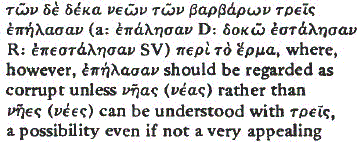 one. (Read
one. (Read ![]() see CQ N.S.27 (1977), 92 ff.).Google Scholar
see CQ N.S.27 (1977), 92 ff.).Google Scholar
48 Russo, (Gnomon 30 (1958), 585) says that V too omits ![]() . It should be noted that the manuscripts that omit
. It should be noted that the manuscripts that omit ![]() are among those that have
are among those that have ![]() , anyway.Google Scholar
, anyway.Google Scholar
49 On ![]() with aor. inf. without iiv see E. Fraenkel's commentary on A. Ag. 675–6.
with aor. inf. without iiv see E. Fraenkel's commentary on A. Ag. 675–6.
50 Fut. inf. 2.24.2.22; 7.14.2.2; 14.5.14; acc. and fut. inf. 3.2.7.4; 5.26.11.27. Elsewhere only acc. and pres. inf.: 3.20.6.5.
51 Cf. the use of ![]() with a past tense indicative in the next paragraph, 1.14.1.
with a past tense indicative in the next paragraph, 1.14.1.
52 (a) For ![]() meaning ‘light’,
meaning ‘light’,  .
.
(b) Confusion (see, with app. crit., e.g. A. Ag. 340 (see Fraenkel, E.ad loc.); 1094Google Scholar; Pers. 650; Pr. 963; Supp. 606; S.O.T. 1387), and the possibility of confusion (e.g. A. Ag. 280; S. Aj. 1144;El. 373; O.C. 927;  …); D. 18.224; 18.258; 19.312; Th. 1.11; Ach. Tat. 2.20.1.13; 4.13.4.9; 6.1.3.13; 8.9.8.10) of
…); D. 18.224; 18.258; 19.312; Th. 1.11; Ach. Tat. 2.20.1.13; 4.13.4.9; 6.1.3.13; 8.9.8.10) of ![]() , of course, common. Usually a simple verb and its compound in tw- have substantially different meanings, one of which would be evidently unsuitable in a particular passage, and this goes to determine the word
, of course, common. Usually a simple verb and its compound in tw- have substantially different meanings, one of which would be evidently unsuitable in a particular passage, and this goes to determine the word 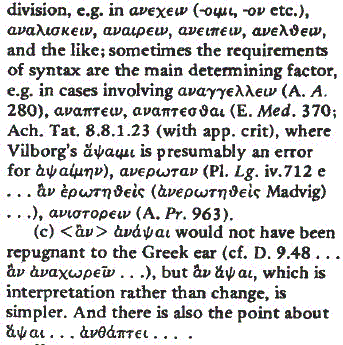
53 Ach. Tat. may also have coined ![]() (8.4.1.11),
(8.4.1.11), ![]() (3.2.2.13; cf. Eust. 1885.19), and
(3.2.2.13; cf. Eust. 1885.19), and ![]() (6.18.5.26). On p.173 of his edition Vilborg marks
(6.18.5.26). On p.173 of his edition Vilborg marks ![]() (5.8.3.1) too as
(5.8.3.1) too as ![]() , but see LSJ s.v.
, but see LSJ s.v.
54 The fact that Clinias did not buy the horse actually as a present for Charicles (1.7.1) is neither here nor there: it became a love-present so soon after its purchase that Clinias, especially in his distress, might well speak of himself as having bought it for, as well as to the ruin of, Charicles.
55 1.13.5.28 ![]()

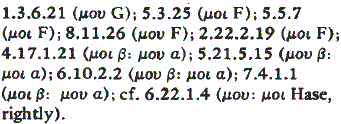 .
.
56 Cf. 1.15.8.25 ![]() .
.
57 On returning to Jacobs I find that he says this ad loc.: ‘Mihi in mentem venit:  than copulative) is entirely unnatural.
than copulative) is entirely unnatural.
58 The editors, however, should not be thought of as having adverted to this. See Reeve, , CQ N.S. 21 (1971), 515.CrossRefGoogle Scholar
59 Reeve's, category 4(b); see op. cit. 516 and 522.Google Scholar
60 Elsewhere alone or with dat., though ![]() acc. in Pl. Ti. 57 d (cf. X. H.G. 1.3.7; id. Cyr. 7.4.11; Arist. Mete. 354a1).
acc. in Pl. Ti. 57 d (cf. X. H.G. 1.3.7; id. Cyr. 7.4.11; Arist. Mete. 354a1).
61 Compare e.g. Ach. Tat. 1.2.3 with Phdr. 229 f.; 1.4.4 (and 1.9.4–5; 5.13.4) with 251 b: 1.6.6.6 with 251 e; 1.9.4.20 (and 5.13.4.20) with 251 b; 1.9.6.3–4. with 240 c; 1.9.6.5–6 with 255 d; 1.15.4.6–7 with 230 b.
62 ![]()
![]() in mingled (chequered) shade' as is clear from the contrast with
in mingled (chequered) shade' as is clear from the contrast with ![]() ‘in a dense shade’ LSJ, wrongly. Anyone who needs an example of
‘in a dense shade’ LSJ, wrongly. Anyone who needs an example of ![]() really meaning ‘dense’ will find one in Plu. Caes. 717 f
really meaning ‘dense’ will find one in Plu. Caes. 717 f ![]() (of the Nervii).
(of the Nervii).
63 For ![]() and acc. expressing response to, correspondence with, cf.
and acc. expressing response to, correspondence with, cf. 
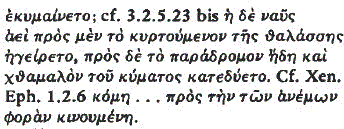 .
.
64 The mottled appearance of the shadow cast by the latticed reed support and the vines is not adequately expressed by ![]() alone.
alone.
65 Merely to omit ![]() (as a gloss on
(as a gloss on ![]() ) would create hiatus. Besides, it does add something to the description. It is not impossible that the context in Phdr. 239 c suggested
) would create hiatus. Besides, it does add something to the description. It is not impossible that the context in Phdr. 239 c suggested ![]() to Ach. Tat. here: the shadow, like the boy, is beautiful but (and because) pale. The omission of Kai is a frequent error: see, with app. crit., e.g.
to Ach. Tat. here: the shadow, like the boy, is beautiful but (and because) pale. The omission of Kai is a frequent error: see, with app. crit., e.g.  .
.
66 CQ 29 (1935), 101.Google Scholar
67 Jackson's insertion does not substantially change this, merely adding a link to the chain.
68 CQ 29 (1935), 101.Google Scholar
69 Something with at least the sense of![]() .
.
70 See the next sentence in the text.
71 ‘Our text shows no other instances of 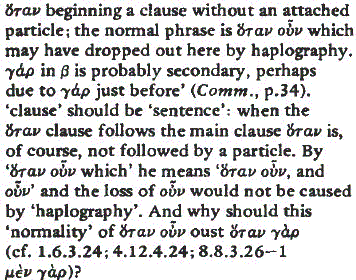 .
.
72 For a parenthetic ![]() clause preparing for what follows it see 5.3.4.24
clause preparing for what follows it see 5.3.4.24 ![]()
![]() In the following places a parenthesis with
In the following places a parenthesis with ![]() interrupts the structure of the clause to which it refers and at least the main substance of what is referred to follows the
interrupts the structure of the clause to which it refers and at least the main substance of what is referred to follows the 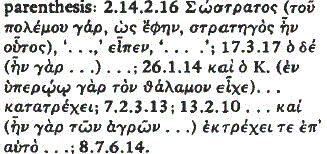 .
.
73 ![]() in Ach. Tat. elsewhere only at 8.17.3.22
in Ach. Tat. elsewhere only at 8.17.3.22 ![]()
![]() the contrary, … (see Denniston, J. D., The Greek Particles (Oxford, 1954 2), p.107). With my interpretation here cf. Denniston, pp.98–9.Google Scholar
the contrary, … (see Denniston, J. D., The Greek Particles (Oxford, 1954 2), p.107). With my interpretation here cf. Denniston, pp.98–9.Google Scholar
74 Comm., p.36. The sea, already mentioned, of course implies the shore.
75 To take ![]() (subst.) as subject with
(subst.) as subject with ![]() as complement would, of course, in the resulting sense be more or less to put the cart before the horse. Perhaps at least the scribe to whom the order in G is owed (see Vilborg's, edition, p.lxiv) saw this and, failing to see the possibility of taking 6 as a pronoun, changed the word-order.Google Scholar
as complement would, of course, in the resulting sense be more or less to put the cart before the horse. Perhaps at least the scribe to whom the order in G is owed (see Vilborg's, edition, p.lxiv) saw this and, failing to see the possibility of taking 6 as a pronoun, changed the word-order.Google Scholar
76 ![]() before a vowel: 2.21.4.6; 34.5.22; 5.17.6.3. Cf. 2.22.7.14
before a vowel: 2.21.4.6; 34.5.22; 5.17.6.3. Cf. 2.22.7.14 ![]()
![]() .
.
77 Scribal omission of ![]() In: 2.21.4.6 (om. G); 5.26.12.30 (om. a); 7.5.2.6 (om. β); 8.5.5.14 (om. G).
In: 2.21.4.6 (om. G); 5.26.12.30 (om. a); 7.5.2.6 (om. β); 8.5.5.14 (om. G).
78 Emphatic ![]() in a forward position separated from the word it modifies:
in a forward position separated from the word it modifies: .
.